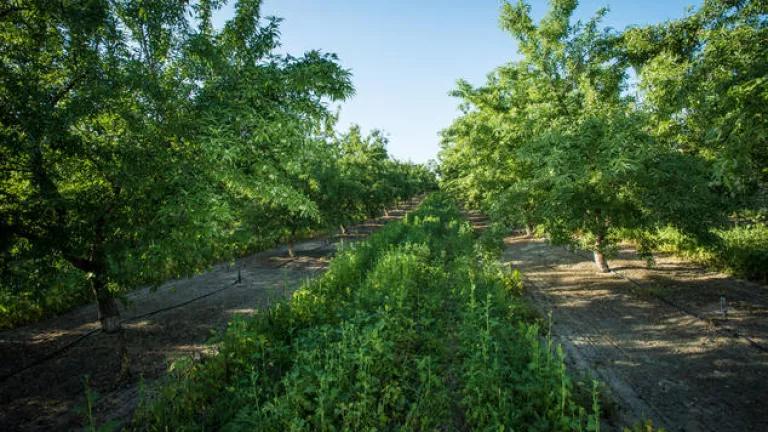How the Food Industry Can Fight Fires in the Amazon
By diversifying their menus, American companies can drive positive change.

Smoke rises from fires in the Amazon rainforest near Porto Velho, the capital of Rondônia, Brazil, August 26, 2019.
By diversifying their menus, American companies can drive positive change.
The Amazon is the largest tropical rainforest in the world and currently prevents an estimated two billion tons of carbon from entering the atmosphere each year and fueling global warming. At the same time, its destruction is one of the leading contributors to climate change, accounting for over 10 percent of the world’s climate pollution. One in 10 known species on the planet lives in the Amazon rainforest. We can’t solve climate change or preserve biodiversity if the world’s intact forests, like the Amazon, are destroyed.
Despite its critical importance, the Amazon is currently under assault by the largest number of fires in a decade—almost double the number last year at this time. With rainfall just a little below normal and no major climate shifts in the region, a researcher with the Brazilian National Institute for Space Research (INPE) points to human activity as the leading cause.
"The dry season creates the favorable conditions for the use and spread of fire, but starting a fire is the work of humans, either deliberately or by accident,” INPE researcher Alberto Setzer told the BBC. Land grabbers often unleash fire to clear forests in order to sell the land to ranchers and farmers for cattle and soy, getting more for clear land than for acreage covered in trees.
The production of meat is a major driver of this destruction. According to the Yale School of Forestry Global Forest Atlas, 62 percent of the cleared area in the Amazon is used for cattle grazing. The United Nations Food and Agriculture Organization estimates that the number of cattle in the Amazon basin increased from approximately five million in the 1960s to 70–80 million in the 2000s. Eighty percent of the beef raised in Brazil is eaten domestically. The rest is shipped to other countries, making Brazil the largest exporter of beef in the world.
Soy, largely used to feed chickens, pigs, and cows in Brazil and the European Union, is another culprit. Brazil is one of the world’s largest exporters of soy, and 13 percent of its crop grows in the Amazon.
A new report by the environmental group Mighty Earth maps the proximity of the Amazon fires to slaughterhouses and soy facilities run by multinational companies. These companies process and export much of the beef and soy that are driving the fires. They must take responsibility for their supply chains and ensure their products are not driving deforestation.

Cattle graze after a fire in the Amazon rainforest in the state of Para, Brazil, August 25, 2019.
Most beef from Brazil is banned for sale in the United States, and the vast majority of the Amazon’s beef is exported to other countries like Russia and China. U.S.-based companies, however, can help to reduce demand for beef around the world by shifting menus right here in the United States. Rapid international expansion of U.S. fast-food chains that feature meat-intensive menus, for instance, is helping to increase demand for meat around the globe. By shifting menus right here at home—for instance, by reducing meat and including more plant-based alternatives, as some companies have already started doing—Americans can help stop exporting a culture of beef, chicken and pork and instead drive positive change.
Large food service providers can also play an important role in shifting U.S. menus toward more plants. While most of these large providers, including Aramark, do not directly purchase Brazilian beef, they are among the top sellers of meals in America. They feed millions of people daily at large facilities like stadiums, universities, and hospitals around the country and play a major role in our dietary culture. Cutting their purchases of red meat by just 30 percent would be the equivalent of taking a million cars off the road for 10 years.
That’s why NRDC and others are calling on Aramark to establish a concrete target to reduce livestock purchases and meat offerings on its menus. Last fall, NRDC was one of 70 organizations that delivered a letter to the company asking for this commitment.
With news earlier this week that Aramark’s CEO is abruptly resigning in response to private investor pressure, there’s no better time for the company to reevaluate what it stands for and how it wants to serve its customers into the future.
Watching the Amazon burn from thousands of miles away, we can feel overwhelmed by the destruction. But it turns out that our actions here at home can help to save our forests, and it starts with our plates. By shifting how the meat industry raises and feeds livestock and shifting our menus toward more plants, we can make a major difference. Big companies that lead the world’s meat and meals markets have the power and responsibility to lead these changes.
The world is watching, and we can’t afford to wait.





